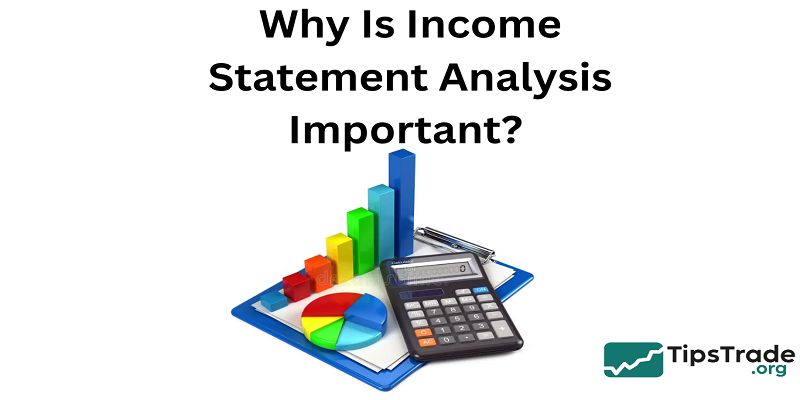Income Statement Analysis is a vital process that helps investors, managers, and stakeholders evaluate a company’s financial performance over a specific period. The income statement summarizes revenues, expenses, gains, and losses, offering insight into profitability, operational efficiency, and cost management. Through this article, let’s explore the methods of analyzing income statements, key metrics to focus on, and how such analysis supports informed financial decisions. For more detailed and expert insights, please visit https://tipstrade.org/.
What Is an Income Statement?

Key Components of an Income Statement
-
Revenue (Sales): Total income generated from selling goods or services. It represents the top line and reflects core business activity.
-
Cost of Goods Sold (COGS): Direct costs attributable to the production of goods sold, including materials and labor, used to calculate gross profit.
-
Gross Profit: Calculated as Revenue minus COGS. It shows how efficiently a company produces and prices its goods.
-
Operating Expenses (OPEX): Includes selling, general and administrative expenses (SG&A), salaries, rent, marketing, research & development, and depreciation.
-
Operating Income (EBIT): Earnings before interest and taxes, calculated as Gross Profit minus Operating Expenses. This reflects profitability from primary business operations.
-
Net Income: The final profit after subtracting interest, taxes, and other non-operational expenses from operating income. This is also known as the bottom line.
Example
For Company A:
-
Revenue = $1,000,000
-
COGS = $600,000
-
Operating Expenses = $250,000
-
Taxes and Interest = $50,000
The Net Income would be 1,000,000−600,000−250,000−50,000=100,000.
Purpose and Use
The income statement provides insights into how revenues are transformed into net earnings or losses, helping stakeholders evaluate financial health, performance trends, and profitability. It complements other financial statements like the balance sheet and cash flow statement for a comprehensive analysis.
Why Is Income Statement Analysis Important?

-
For investors: It helps assess long-term profitability and growth potential before buying shares by analyzing revenue trends, profit margins, and cost management. This prevents focusing solely on net profit, as consistent revenue growth with stable margins better predicts long-term success.
-
For managers: Income statement analysis identifies areas for cost control, operational efficiency, and margin improvement. It helps optimize spending and resource allocation by breaking down expenses and revenues.
-
For lenders: It offers a basis for evaluating the company’s repayment ability and financial risk exposure through profitability and operational performance.
-
For entrepreneurs: It measures scalability and business sustainability by tracking ongoing revenue growth and cost trends, which guides strategic planning and operational adjustments.
Research from PwC highlights that consistent revenue growth combined with stable margins is a more reliable indicator of long-term success than net profit alone, emphasizing the importance of analyzing diverse income statement components rather than a single bottom-line figure.
Income statement analysis enables trend monitoring, regulatory compliance, micro-level insights into departmental spending, and performance comparison over multiple periods.
This comprehensive understanding helps stakeholders detect financial strengths, weaknesses, and opportunities for growth, ensuring better financial health management.
Step-by-Step Guide to Analyzing an Income Statement

H3: Step 1 – Revenue Analysis (200 words)
Revenue is the top line, and it shows how well the company attracts customers. Look for:
- Multi-period growth trends (YoY, QoQ).
- Organic vs. acquisition-driven growth.
- Comparison with competitors and industry benchmarks.
Case: If a SaaS company’s revenue grows 20% YoY while the sector average is 12%, it indicates strong market penetration.
Step 2 – Gross Profit Margin (200 words)
Gross Margin Formula:
Gross Margin=Gross ProfitRevenue×100\text{Gross Margin} = \frac{\text{Gross Profit}}{\text{Revenue}} \times 100Gross Margin=RevenueGross Profit×100
A high gross margin signals pricing power and production efficiency, while a declining margin may indicate rising costs or competitive pressure.
Example: Company A earns $1M in revenue, $600K COGS → Gross Margin = 40%.
Step 3 – Operating Performance
Operating performance focuses on Operating Income (EBIT) and Operating Margin.
- Operating Expenses: Salaries, rent, marketing, R&D.
- Operating Margin = EBIT ÷ Revenue.
If OPEX grows faster than revenue, margins shrink.
Case Study: In 2022, many tech firms saw revenue growth but declining operating margins due to inflated R&D and hiring costs.
Step 4 – Net Income & EPS
Net Income is the bottom line—profit after all costs.
- Net Profit Margin = Net Income ÷ Revenue.
- Earnings Per Share (EPS) = Net Income ÷ Shares Outstanding.
EPS is especially important for public companies as it affects stock price valuations.
Example: Apple’s Q4 2022 report showed EPS growth despite supply chain pressures, signaling strong cost management.
Key Ratios in Income Statement Analysis
| Ratio | Formula | Insight |
| Gross Margin | Gross Profit ÷ Revenue | Production efficiency |
| Operating Margin | EBIT ÷ Revenue | Core business profitability |
| Net Margin | Net Income ÷ Revenue | Overall profitability |
| Interest Coverage | EBIT ÷ Interest Expense | Debt risk |
| EPS | Net Income ÷ Shares Outstanding | Profit per share |
Always benchmark against industry averages. For instance, retail margins average 2–5%, while software companies often achieve 20–30%.
Common Red Flags in Income Statements

-
Declining Revenue Despite Higher Spending: Indicates inefficiency or loss of sales power despite increased investment, signaling operational troubles.
-
Falling Gross Margins: Suggests cost inefficiencies, rising production costs, or pricing pressure, reducing profitability.
-
High Interest Expenses: Implies excessive debt burden which increases financial risk and reduces net income.
-
One-Time Gains or Losses: Large irregular items can mask the true performance in that period, hiding underlying business issues.
-
Aggressive Revenue Recognition: Premature or fictitious revenue inflates earnings artificially, a classic sign of earnings manipulation.
A historical example is Enron, whose income statements looked profitable due to complex accounting tricks and aggressive revenue recognition but ultimately led to bankruptcy when the scheme unraveled.
Case Study – Real-World Income Statement Analysis

Let’s analyze Coca-Cola’s 2022 Income Statement (simplified):
- Revenue: $43B
- COGS: $17.5B
- Gross Profit: $25.5B → Gross Margin = 59%
- Operating Expenses: $15B
- Operating Income: $10.5B → Operating Margin = 24%
- Net Income: $9.5B → Net Margin = 22%
- High gross margin reflects Coca-Cola’s strong brand and pricing power.
- Operating expenses are well-managed, leaving healthy margins.
- Net income stability signals resilience despite inflationary pressures.
Advanced Techniques in Income Statement Analysis

Horizontal Analysis
- This technique compares income statement line items over multiple periods, showing dollar or percentage changes from one period to another.
- It helps identify growth rates, trends, and fluctuations over time, enabling users to see how revenue, expenses, and profits evolve.
- For example, comparing quarterly revenues across years to track consistent growth or identify seasonal patterns.
Vertical Analysis
- Vertical analysis expresses each line item as a percentage of a base figure, typically total revenue (sales).
- This method converts absolute numbers into relative proportions, making it easier to benchmark performance against other companies or industry standards, regardless of company size.
- It highlights expense structures and profit margins by showing the weight of each item relative to sales.
DuPont Analysis
DuPont analysis breaks down Return on Equity (ROE) into three components:
-
Profit Margin (Net Income ÷ Revenue): Measures profitability,
-
Asset Turnover (Revenue ÷ Assets): Indicates operational efficiency,
-
Financial Leverage (Assets ÷ Equity): Reflects the extent of debt used.
This decomposition helps understand what drives overall Returns on Equity, pinpointing whether profitability, asset use, or leverage has the biggest impact.
Trend Analysis
- Trend analysis looks at multi-year historical data to identify patterns in revenue growth, profit margins, and earnings per share (EPS).
- Identifying positive or negative trends supports forecasting future performance and informs strategic decisions.
- It is particularly valuable in assessing long-term business sustainability and cyclicality.
Conclusion
Income Statement Analysis provides critical information for assessing profitability and business operations, enabling better management strategies and investment decisions. Understanding the components of the income statement allows stakeholders to identify growth trends, cost drivers, and margins effectively.

